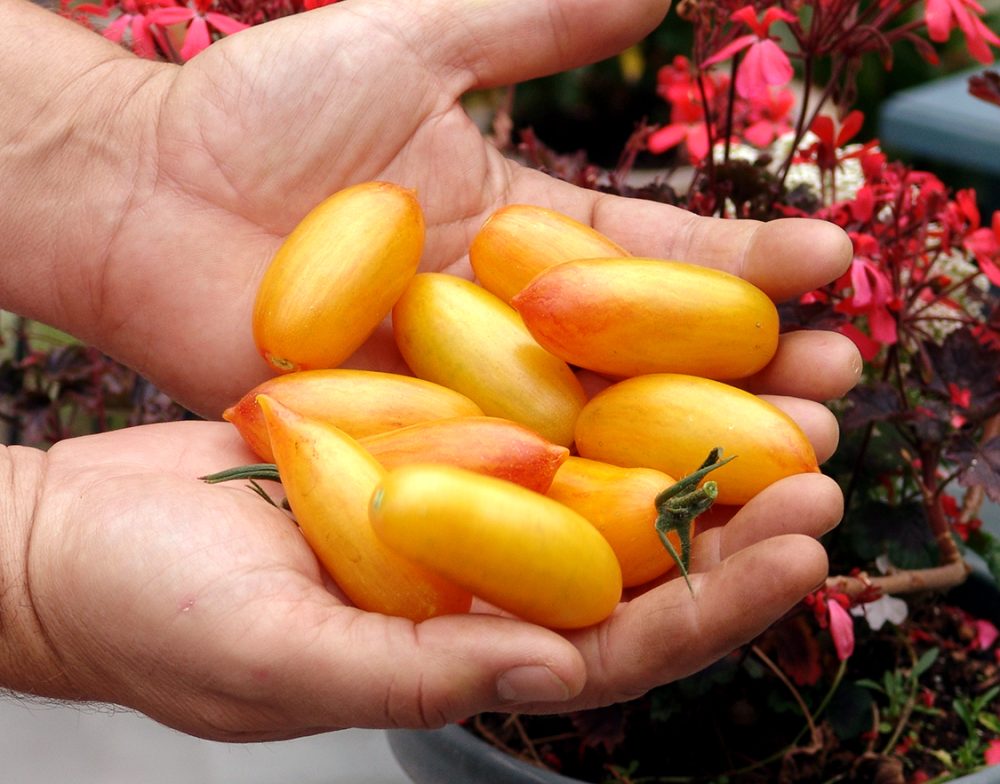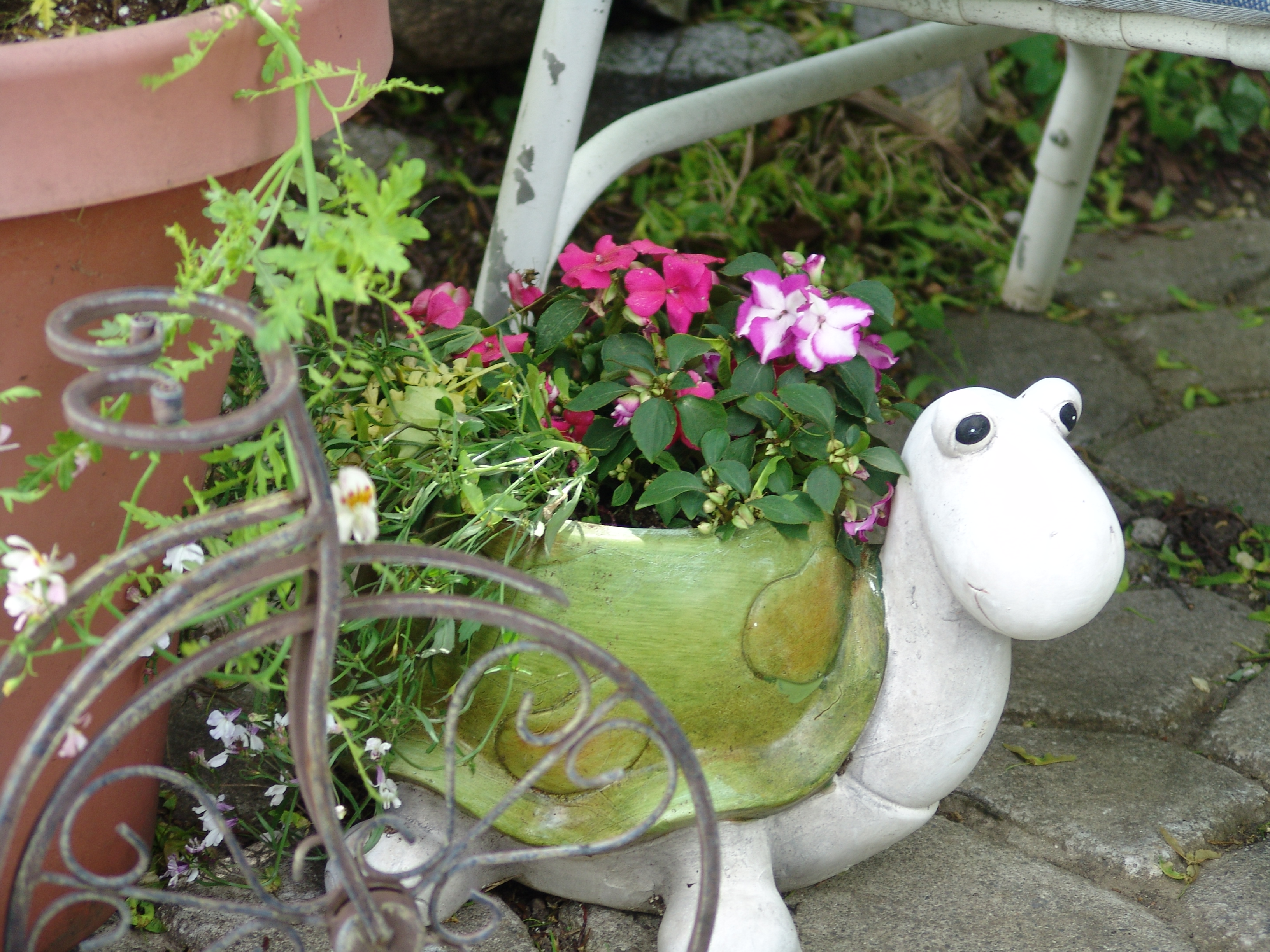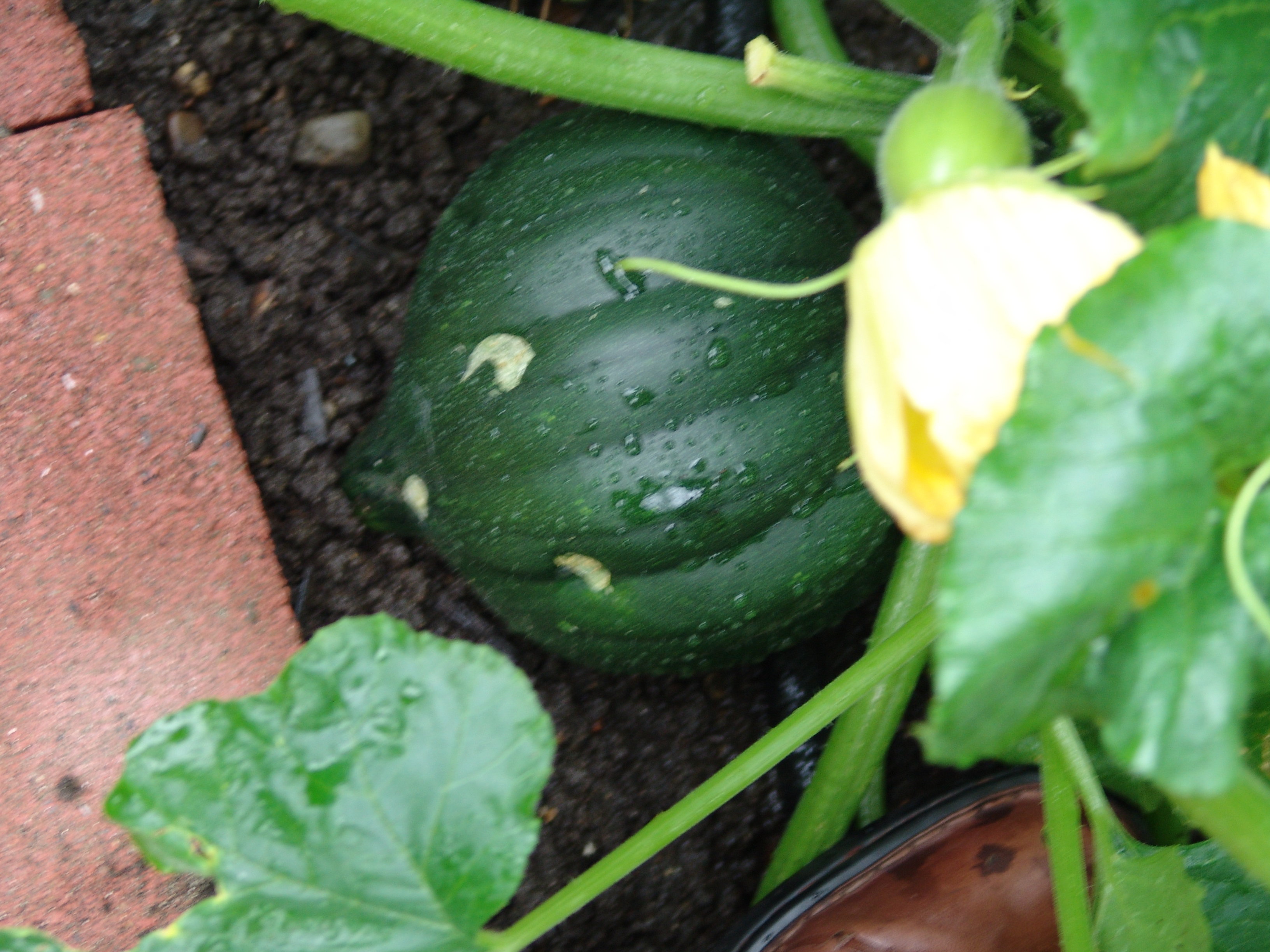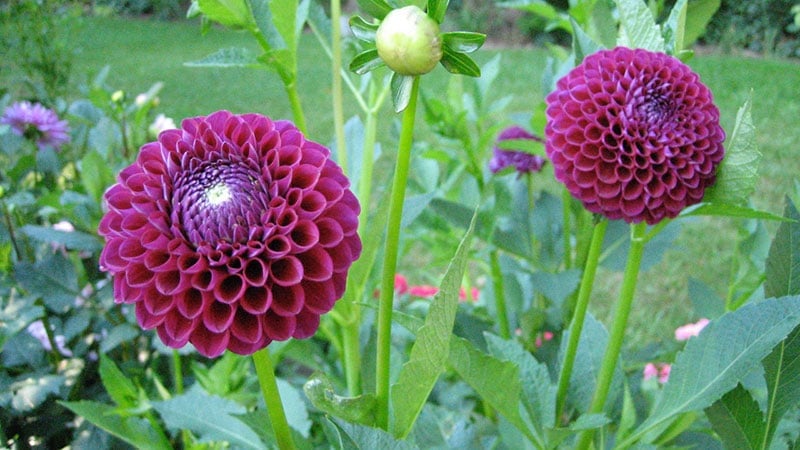
This is one of the last Greek Rose that we picked from our garden for this year. They are lovely and very large and delicious. This one was so big, it seemed to be identifying as a pumpkin! This one is just for fun! Happy Fall!


Wishful thinking, one summer in years gone by. Warm weather, monster tomato plants on our homemade tomato cages.

Our gallon pots that we are selling now
First, let me apologize, I fully expected to be able to continue this thread and then life got crazy! We started selling our plants much earlier than we had planned to. The Garden Expo we were camping up for was canceled due to the virus situation, and that is a third of our sales. I wish this was my “hobby” but it’s around 50% of our income so we had to scramble to figure out how we were going to overcome this serious setback. Instead of 1500 gallons, we had 3000! Thankfully, we are considered an essential business and we knew that the “new normal” would make selling a lot more difficult so we started to sell early. Everyone had been very generous and understanding. I lowered the price of my gallons by $2, they are now $8.00 and have changed the way we are getting plants to the customer. Curbside delivery, home delivery with minimum orders, appointments, social distancing, monitoring how many in a greenhouse at a time (1) husband and wife are considered as one person, if they haven’t caught it from each other at home they won’t be catching it in the greenhouse! Fun times! Apologies aside here is the long-awaited post.

Cute little guy with impatiens. For a shade garden, small soil cavity so better for a shade garden where it won’t dry out as fast.
So far we have discussed basic tips on raised bed gardening, in-ground gardening and edible landscaping which simply means including vegetable plants in your decorative gardens. I am a big believer in container gardening, for vegetables, for flowers, and for both mixed together. Edible container gardens don’t need to be boring or plain or merely functional. In container gardens, there is a design principle that most of us learn, thrillers, fillers, and spoilers.

For a shade garden – wax begonias, impatiens and alyssum in a “flower bed”
Thrillers are your focus plant. It is the dracaena spike, coleus, begonia, ornamental grasses anything that is a big, eye-catching focal point. In an edible container garden, it would be your tomato plant, cucumber vine, lettuce etc. Can you imagine growing carrots, with their ferny, frothy foliage in the middle of a large container surrounded by flowers? Sweet.

Krainy Sever, a dwarf tomato with petunias and lobelia
Fillers are mid-size, mounding or rounded plants that surround your focal plant. You can use it to complement or contrast the colors of the focal plant. If it is a dappled shade garden, wax begonias, gazania, ageratum, impatiens would be good choices. Petunias, mounding lobelia, alyssum, ivy geraniums, nasturtiums, and million bells, are all good choices for plants in containers in the sun.

Pansies and alyssum as a fluffy white skirt in a coffee pot
Spillers are plants that tumble over the sides of the container, softening the edges and providing more color. Bacopa, petunias, alyssum, trailing lobelia, sweet potato vine, ivy, are good choices.

Salad Bowls – various lettuces in colanders with alyssum and lobelia
Light, Temperature, Nutrition
Some plants can work in partial, dappled shade, million bells, lobelia, alyssum, bacopa, petunias, and geraniums. Very versatile. This leads me to my next point: keeping in mind the various light, temperature and nutritional needs of the plants.
I would never put coleus and petunias in the same pot. Coleus, for the most part, like shade (although there are new sun-tolerant varieties coming out today), Petunias do better with more sun. Vegetables also do better with more sun. Lettuce would be a good filler or focus plant for partial sun. Tomatoes need a lot of sunshine to be prolific. anything that produces fruit, such as tomatoes or cucumbers, need a lot of energy to form it.
Think of putting drought-tolerant plants together, shade-loving plants, or sun-loving plants in the same pots. Temperature is another factor although I think of it more in terms of succession planting. Pansies and Schizanthus like cooler temperatures and lots of sun. One of my favorite combinations to plant is a tomato or lettuce plant (which also likes cooler temperatures), petunias, lobelia and alyssum. When the cool weather plants succumb to the heat, or I eat the lettuce, the petunias alyssum and lobelia take over. I can also insert other plants in their place. Two-season beauty!

Lettuce, alyssum, and a tomato in a pot, probably a Tumbler
When choosing your vegetables for your pots, choose varieties that are developed for containers. Determinate or dwarf tomato plants, compact pepper plants, carrots that are short in length, cucumbers that don’t vine too much, squash with a more compact shape, bush beans, (if you had a large pot, you could do a pole bean and trellis it), spinach, beets. and even melons. Look for words like “compact”, “determinate”, “short vines”, “small” and “dwarf”.
The picture above shows “Small Wonder” spaghetti squash, “Spacemaster” cucumber plant and fingerling potatoes in pots. Below are carrots that I grew as an experiment in pots. They were amazing!

Carrots in a square pot

Sweet Reba acorn squash
“Sweet Reba” (above) is a good candidate for a large container since it is a compact plant.
Here are some good choices for vegetables:

Coffee anyone?

Tomatoes and flowers in a large pot
Let’s not forget herbs. Most herbs like to live in pots. Purple Basils add a nice punch to a container. Thyme would be a good spiller.
In the end, we are gardeners. We try everything, if it works great, if not we try again!
Here are a few pots that I have done over the years.

Costoluto Genovese The fluted, old Italian favorite that has been around since the early 19th century. Fruit is rather flattened and quite attractive with its deep ribbing. This variety is a standard in Italy for both fresh eating and preserving, and known for its intensely flavorful, deep red flesh. They were also one of the varieties planted at Thomas Jefferson’s home in Monticello in 1809.

Costoluto Fiorentino Heavily ribbed (costoluta) flat Italian heirloom beefsteak type from Florence. Red, 12-16 ounces slightly flattened fruit. Outstanding taste. Large, vigorous, indeterminate plant with good production. Similar to Costoluto Genovese but slightly flatter and higher-yielding.
Costoluto refers to the distinct flattened, heavily-ribbed shape of various Italian heirlooms. Both of these tomatoes are shaped like this. some of my customers don’t like the ribbing but I think it is pretty and the taste is good. There is a reason these are heirlooms!
Both these pics are from my garden the year that I grew them.
We have some new tomatoes that I was just tickled to find. They were developed locally at the University of Idaho. Latah, Moscow, Sandpoint, and Shoshone, I have great expectations for these four. Here is what I found on the Snake River Seed Cooperative site. I discovered this company only just last year. I was happy to find seeds that are bred to be acclimated to our region, (although there are many microclimates in this area). I also believe in buying local whenever I can. This is what the Snake River Seed Cooperative has to say about themselves and their seeds (the short version):
“Snake River Seed Cooperative is a collective of family farmers in the Intermountain West who work together to produce a wide diversity of locally-adapted seeds.”

LATAH Early, productive, and yummy variety bred by University of Idaho–perfect for containers! Latah county growers Kelly and Russell Kingsland grow this little gem, and they offer this description: Compact determinate. Bred at UI (in Latah County), Latah is well suited to Idaho’s cooler nights and relatively short growing season. A prolific producer of 2-3 oz, delicious well balanced, red fruits with good texture.

MOSCOW The largest of the U of I bred tomatoes. Good slicer and canning tomato. Not the earliest of the U of I bred tomatoes, but certainly the largest. Big, indeterminate plants spit out dozens of large, 4-5″ red fruits good for slicing and canning. Almost lost to the ether but for a Utah gardener who kept it as his main canning tomato.

SANDPOINT The smallest and earliest of Idaho bred varieties…great for containers! Extremely early variety bred by the U of Idaho in the 1960s. Small fruits range from cherries to saladette size, on very compact plants–excellent for containers, and for short-season areas.

SHOSHONE Early-ripening Idaho-bred tomato! Compact plants with lots of round red fruits! Of all the varieties bred by the U of ID in the 1960s, Shoshone tied for the earliest harvest and blew the standard early-ripening varieties out of the water for taste, compact plant size, and productivity. Excellent for containers and small spaces. Fruits vary in size from cherry to large saladette tomato.
Keep in mind that I haven’t grown these yet in my garden so these aren’t my pictures. They are ones that I found in doing an internet search. Next year they will be my own. I love taking lots of pictures of everything I grow. Most of them I am pretty proud of.
I hope that these varieties will help some of my more northern customers be more successful with their tomatoes.

One of my many harvests last year. Wishful thinking!
it’s been very cold here or maybe I am just getting older. Lots of sunshine and the birds are starting to make melodies so I expect it to be considerably warmer than it feels. I go through this every year right around February.
I have transplanted 0ver 900 pepper plants already and they are snug as a bug in a rug in our “pepper greenhouse”. I planted 62 varieties this year and will be showcasing some of the newer and favorites on this blog in the future.
As for tomatoes? This year I have over 200 varieties, by far the most that I have ever done. Last year I had 178 and wanted less. Yup, you can blame it on the catalogs. With their pretty pictures and fantastical descriptions such as “the best tasting”, “brilliant color palette”, “earliest for northern regions”, “most prolific”, “an heirloom older than dirt” etc. (the last one, not really, but it sounds like something someone would say.)
I got rid of some I didn’t like or that were hard to sell and of course, kept my favorites and the favorites of my customers. In all, what with taking away and adding, I have 203 varieties. Uh huh, that is a lot! I order mostly from seed catalogs like Seeds n Such, Totally Tomatoes, Tomatofest, Harris Seeds, Johnny’s Seeds, High Mowing Seeds, and others. I also peruse our local Northwest Seed and Pet for their offerings. This year I found some seed by Snake River Cooperative, Shoshone, Moscow, Latah and Sandpoint, seeds developed in our area by Idaho State University. I am anxious to try those and see how they do.
As with the peppers, I will showcase some of the tomato varieties also.
This is my busy season, buying and researching seeds, ordering supplies, figuring out a planting schedule, making big and little tags, ordering preprinted tags, planting and transplanting babies, updating the website, organizing marketing materials and email lists, creating blog posts, watering, fertilizing, arranging heaters and keeping an eye on the temps, taking cuttings and rooting them, to name just a few of my responsibilities
Good thing I love what I do!.
Today, I transplanted 557 baby flowers into their 3.5′ pots. Pansies (Bolero, Fizzle Sizzle Mix and then the Yellow and Blue, Chianti, Colussus, Super Swiss Giants, Heat Elite, and Flirty Skirts), Petunias (Silver Tidal Wave, Dolcissima Flambe, Subperbissima Doubled, Fluffy Ruffles, Pico Bella, Spellbound in Pink, Wine Red, Dark Purple and White Blush, and Evening Scentsation), Impatiens (Accent Mystic, Red Flash, Star, Athena Red Flash, Athena mix Impressa Cherry Splash and Shady Ladies Blushing Beauties, alyssum, and Verbena (Peaches and Cream and Scentsation) tomorrow the alyssums and lobelias. Pansies and Petunias are some of my very favorite flowers.
Of course, nothing looks like this but hope springs eternal, at least for us gardeners. Winter has finally shown up and we have almost a foot of snow on the ground, maybe a little more. I had my stereo on and a heater keeping me warm as I transplanted, dreaming of summer days and bright happy faces of pansies. I do love the snow but it is mid=February and it should be done by now. Maybe next year we could have winter in December and January!
Oh, I also planted the one Godetia that came up. The seed was pretty old.
 Those of us who save our dahlias have probably encountered this problem. I know I have. Here is the answer to that question courtesy of Garden Making. I believe they are out of Canada so they use celsius temperature which is easily convertable.
Those of us who save our dahlias have probably encountered this problem. I know I have. Here is the answer to that question courtesy of Garden Making. I believe they are out of Canada so they use celsius temperature which is easily convertable.
What to do when stored dahlia tubers sprout early? By Garden Making
Question: Michael in Niagara-on-the-Lake, Ontario, asks:
Dahlia tubers that were stored in peat moss in the basement have started to send up shoots. They’re in the coldest part of the basement, but it is 14 to 16°C in the room with about 35% humidity. Should the sprouts be trimmed off? Left alone?
Answer: Nick Vanderheide of Creekside Growers in Delhi, Ontario, says:
The issue at hand is really the storage conditions. Dahlias will sprout under warm, damp conditions, and anything above 10° C is considered warm. The humidity level of the room may very well be 35%, but do you know what the humidity is in the peat moss? You want to maintain a decent amount of moisture in the tubers (not the media it’s stored in) so at 35% room humidity, it is a good thing to put them in peat moss to prevent them from drying out.Heat is the big deciding factor in sprouting. Spring soil temperature is usually around 12 to 16°C when we plant and that causes the tubers to sprout, so if they are in a room at that temperature they will definitely start growing.
In the Netherlands, this sprouting is actually how new, true-to-type, dahlias are produced. The tubers are forced indoors to produce little shoots which are then cut off, rooted and grown as plugs to then plant in the field for the summer where they will produce a new tuber that can be harvested in the fall.The shoots on your tubers can be trimmed or not; they will not affect the viability of the tuber come spring time.
One thing to consider, though, is that the tuber is simply a storage organ for the energy it needs to grow come spring time, so if your tubers continue to try to grow, they are using up energy that they need in the spring to become a big, healthy plant.I would strongly suggest getting those dahlias into a colder area to slow down that sprouting. And then stop worrying—spring is only a few short months away!

From right to left: 2 oz, 2.6 z. and 3.6 oz.
Here are three Krainiy Sever tomatoes, recently picked. They are juicy and fairly dense. I placed them together with a quarter for scale. When I read catalogs and see “this plant produces 1 oz. tomatoes in abundance” I always wonder that that looks like.
Having grown tomatoes for at least 20 years, I can tell you their is a wide variance in the weight of tomatoes. It depends on how dense, how juicy, what the seed cavities look like, etc.
The Krainiy Sever is one of the dwarf series that I sold this year.They are a pretty standard tomato, not especially packed with flesh like a paste tomato or hollow like stuffer tomato.
 The biggest tomato I’ve ever grown was a Rose. It weighed over 3 pounds! This variety is very juicy and solid.
The biggest tomato I’ve ever grown was a Rose. It weighed over 3 pounds! This variety is very juicy and solid.

2 oz Krainiy Sever
 2.6 oz Krainiy Sever
2.6 oz Krainiy Sever
 3.6 oz Krainiy Sever
3.6 oz Krainiy Sever
Am spending the day ordering tomato and pepper seeds. I look outside and it is gray and dreary and cold. Doing this tasks makes me long for warmer temps, green grass, the warmth of the sun on my face.
Who knew? Every year I get tired of gardening and watering and thinking up ways to use my produce and start thinking about calling in an asphalt company. Then, long about Christmas, the seed catalogs start arriving and I start dreaming.
There is a new (to me) kind of nasturtium out, called Phoenix.
It’s petals have raggedy edges. The seed came a couple of days age. Looking forward to trying it. The first time I grew them, they were a major aphid magnet. Yuck. I tried again and haven’t had any problems since and they are on my list of favorite flowers now. I also love the variegated Alsaka
.
garden and art
sharing my experiments in crafting
Big plans for a small garden
EXPLORING COVETED LITTLE LUXURIES
Experiences in Backyard Biological Gardening
My weekend baking trials, tribulations and some triumphs
Remarkable Beaded Jewelry, Hair Accessories, & More
random thoughts from an eclectic mind
The latest news on WordPress.com and the WordPress community.